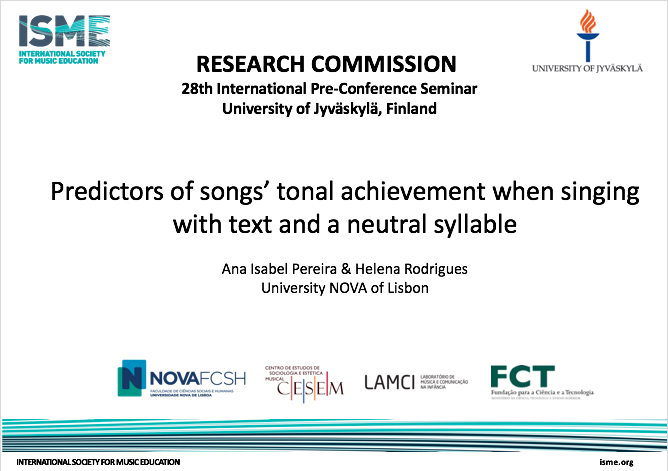27 a 31 Julho 2020 | conferência online com a colaboração da University of Jyväskylä, Finland

Consulte o programa completo da Conferência em: https://www.isme-commissions.org/research-programme.html
Abstract da Comunicação Oral
The purpose of this study was to investigate the influence of the use of singing voice, grade level, and gender on children’s tonal achievement when singing with text and a neutral syllable. One hundred and thirty-five children from K4 to 4th grade, attending a city private school, participated in this investigation. The study encompassed two moments: during Moment One a song with text (Song A) and a song with a neutral syllable (Song B) were taught; during Moment Two the same two songs were taught with text (text was added to Song B). In addition, the Singing Voice Development Measure (SVDM) was administered both with text and a neutral syllable at the beginning of Moment One (before Songs’ A and B instruction), and at the end of Moment Two (the end of instruction). Three independent raters scored songs’ tonal achievement using two researcher-designed rating scales, as well as the use of singing voice using the SVDM. A multiple-regression analysis was conducted in both Moments One and Two. The models were significant, explaining 50% (Song A) and 46% (Song B) of the singing scores in Moment One, and 49% (Song A) and 45% (Song B) in Moment Two. In Moment One, results revealed that the use of singing voice with a neutral syllable is a common predictor of both songs’ tonal scores. In addition, gender predicts Song’s A scores (higher for girls), and grade level predicts Song’s B tonal scores (higher for upper grade levels). In Moment Two, results revealed that all variables predict Song’s A tonal scores (higher for girls, higher for older children, and higher for those with higher use of singing voice both with text and a neutral syllable). All variables except gender predict Song’s B tonal scores. Implications for teaching practices may be made regarding the use of songs with text and a neutral syllable, as well as the use of singing voice. Children in kindergarten through elementary school ages (up to fourth grade) may benefit from classroom activities or singing techniques that prioritize the expansion of vocal registers, with an emphasis on the use of a neutral syllable. Similar results on tonal achievement might be expected for boys and girls if using songs presented with a neutral syllable. Considerations about the assessment process and the measurement tools used are also discussed.
Keywords: children’s tonal achievement, songs with text and a neutral syllable, use of singing voice.
